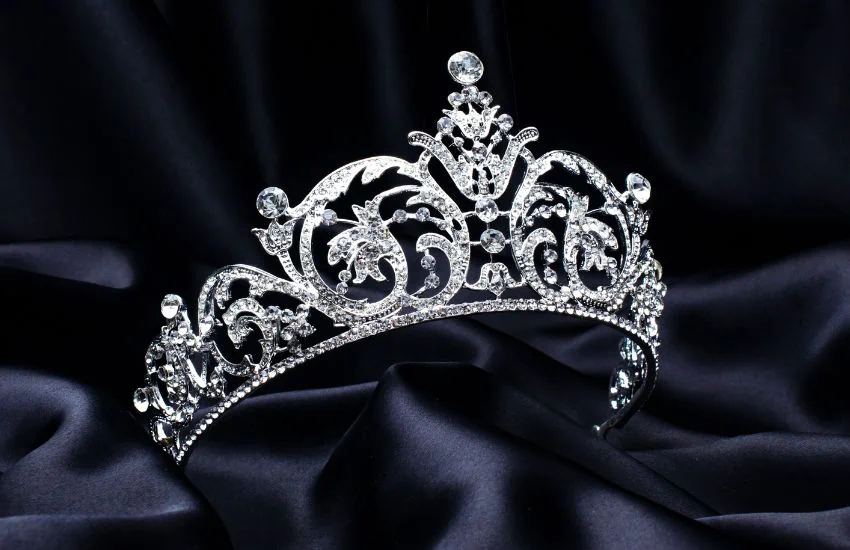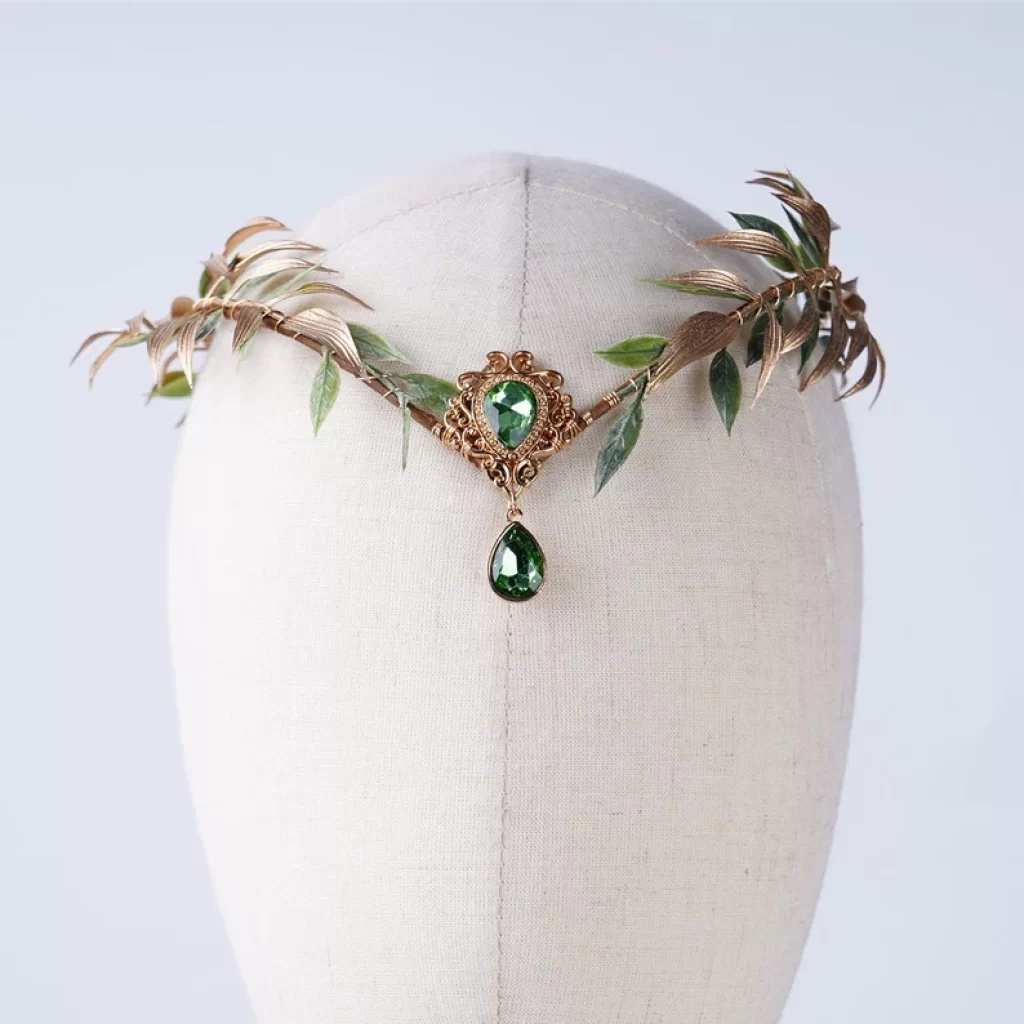
Table of Contents
Both tiaras and diadems are symbols of status and elegance, but they have distinct characteristics and historical significance. A tiara, typically worn by princesses and brides, differs from a diadem, which has deeper roots in royal tradition.
Let’s look at the differences between these two, and their respective roles in history and fashion.
What is a Tiara?

A tiara is a semi-circular, ornamental headpiece traditionally worn by women. Made from metals like gold or silver and often adorned with gemstones, tiaras are associated with nobility and elegance. They’re commonly worn at formal events, weddings, and beauty pageants, symbolizing prestige and celebration. Unlike a full crown, a tiara does not encircle the entire head, typically resting on the forehead or hair.
What is a Diadem?

A diadem is a type of crown or ornamental headband, often made of precious metals and jewels. It is a symbol of sovereignty and authority, traditionally worn by monarchs or deities in various cultures. Unlike a tiara, which is semi-circular and decorative, a diadem is usually a full circular band and signifies royal power. It’s an emblem of rulership and has been used historically in ceremonies like coronations.
Tiara vs. Diadem: Historical Background
The history of tiaras and diadems is deeply embedded in human culture. Tiaras, dating back to ancient Persia, began as high, cylindrical headpieces worn by kings to symbolize divine glory. As time passed, different cultures, including the Greeks and Romans, adopted tiaras, transforming them into symbols of aristocracy and power, especially for women. The tiara evolved into the semi-circular, jeweled ornament popular in the 18th and 19th centuries among European nobility.
Diadems, with a history spanning ancient Egypt and Greece, started as simple fabric bands indicating royalty and sovereignty. Over time, they became more elaborate, jeweled bands representing authority and divine right, notably in the Hellenistic period and Roman Empire. During the medieval and Renaissance periods in Europe, diadems, often intricately designed with precious gems, became standard in royal coronations and ceremonies.
Over centuries, both tiaras and diadems have changed, reflecting shifts in fashion, power, and social norms. Tiaras have become associated with high society and events like weddings, while diadems have maintained their connection to royal symbolism and authority. Their continuous presence in culture and ceremonial contexts highlights their enduring significance as symbols of prestige and power.
Tiara vs. Diadem: Appearance

A tiara is a semi-circular headpiece that sits on top of the head, typically decorating the hair but not encircling it fully. The front part of a tiara is usually elevated, tapering towards the sides. Made mostly of gold or silver, tiaras often feature decorations like diamonds, pearls, and crystals. Their designs range from simple, elegant bands to more intricate, detailed patterns. Tiaras are versatile in design, fitting various styles from traditional to contemporary.
In contrast, a diadem is more of a full circle, similar to a crown but thinner and less heavy. Crafted from precious metals like gold, diadems are adorned with jewels such as diamonds, rubies, sapphires, and emeralds, indicating royalty and authority. Their designs are generally symmetrical, with an even distribution of decorative elements around the band.
Some diadems have a notable centerpiece or peak at the front, adding to their regal appearance. The round shape and even decoration of diadems make them distinct from the more front-focused, semi-circular tiaras.
Tiara vs. Diadem: Symbolic Significance
The tiara and diadem, both ornate headpieces, carry different symbolic meanings steeped in history and culture. Tiaras, linked historically to nobility and high social status, symbolize prestige and elegance. Women of aristocratic families traditionally wore them as a sign of their rank and privilege.
Nowadays, tiaras have taken on broader meanings, symbolizing celebration and achievement, evident in their use at weddings and beauty pageants, representing personal and familial honor.
Diadems, however, symbolize a stronger sense of sovereignty and authority. Originating in ancient times, kings and rulers wore diadems to represent their divine right and power. This association with absolute authority and leadership remains strong. Diadems have mostly kept their ties to royal lineage and governance, contrasting with the more socially diverse use of tiaras. When a monarch wears a diadem, it reflects the deep historical significance of their role and the enduring tradition of monarchy.
While both tiaras and diadems are regal, they differ in their symbolic meanings, highlighting varying aspects of power, status, and tradition.
Tiara vs. Diadem: Use in Different Cultures and Ceremonies

Tiaras and diadems, although similar in appearance, serve different purposes in various cultures and ceremonies, reflecting their distinct cultural and social importance. In Western cultures, brides commonly wear tiaras at weddings as symbols of beauty and grace.
Tiaras also play a significant role in beauty pageants, marking the achievement and status of the winners. For royal events, female members of royal families wear tiaras as part of their formal attire, indicating their aristocratic status.
Diadems, on the other hand, have a more serious and authoritative role, especially in historical and royal settings. Ancient Greek and Roman rulers wore diadems to show their divine authority and governance rights. This practice persists in some modern monarchies, with diadems featuring in coronation ceremonies and official events, highlighting the wearer’s sovereignty and leadership.
In Eastern cultures, tiaras and diadems appear in different forms. For example, traditional Chinese brides wear ornate headpieces similar to tiaras, symbolizing luck and social status. Historical leaders in Asian cultures often donned headpieces like diadems, representing their imperial power and divine heritage. These varied uses of tiaras and diadems in different cultural and ceremonial contexts underline their lasting importance and diverse symbolic meanings across societies.
Tiara vs. Diadem: Design and Style Variations
The designs and styles of tiaras and diadems have changed significantly through history, reflecting various trends and iconic styles. Tiaras, known for their design flexibility, have evolved from heavy, ornate pieces loaded with gemstones and detailed metalwork to simpler, more elegant designs.
Influenced by Art Nouveau and Art Deco, modern tiaras often showcase streamlined, geometric patterns. Today’s tiaras balance between minimalistic designs with delicate gemstones and traditional, elaborate styles for special occasions. Famous examples include Kate Middleton’s Cartier Halo Tiara and Princess Diana’s Spencer Tiara.
Diadems, traditionally more consistent in design than tiaras, have also seen style changes. Originally simple bands, they grew more intricate with the rise of empires like Rome and Byzantium, often featuring symmetrical designs with a central point to highlight the wearer’s status. During medieval and Renaissance Europe, diadems were elaborately crafted with gold and jewels.
Modern diadems maintain a regal, symmetrical look but have adapted to suit contemporary tastes. Examples like the Imperial State Crown of the United Kingdom and the Greek Key Pattern Diadem illustrate the shift from basic bands to elaborate crowns. These design changes in both tiaras and diadems mirror evolving fashion and cultural shifts, while their symbolic importance remains constant.
Tiara vs. Diadem: Who Wears Them?

Traditionally, different people have worn tiaras and diadems, each reflecting unique symbolic meanings and societal roles. Initially, only royalty and aristocracy wore tiaras, symbolizing high social status. Queens, princesses, and noblewomen wore them at formal events. Over time, tiaras have become more widely used, moving beyond just aristocratic circles.
Today, many brides wear them as symbols of elegance and grace on their wedding days, regardless of royal connections. Tiaras are also common in beauty pageants, symbolizing the winners’ achievements and honor. This change has made tiaras popular for various formal and celebratory occasions, not just for royalty.
In contrast, diadems have kept their more exclusive, authoritative role, mainly linked to royalty and sovereign power. Kings, queens, emperors, and empresses typically wear diadems during major events like coronations, state ceremonies, and official functions, representing their ruling authority and divine governance rights.
Unlike tiaras, diadems have mostly stayed within the royal realm and are seldom seen in other settings. This difference underlines how tiaras and diadems, while looking similar, have different uses and are worn by different people, showing their distinct historical and cultural importance.
Tiara vs. Diadem: Modern Adaptations and Fashion
Modern fashion has reshaped the use and design of tiaras and diadems, blending them into today’s styles and occasions. Tiaras, once exclusive to aristocracy, are now a dynamic element in modern fashion. Bridal designers frequently use tiaras to add sophistication and elegance to wedding attire.
These headpieces have also become staples in high fashion, gracing runways and red carpets with updated designs featuring minimalist or avant-garde touches. This combination of classic elegance and modern style has turned tiaras into versatile fashion accessories.
Diadems, traditionally linked to royalty and official ceremonies, have also undergone some modern updates. In the world of high fashion, diadems occasionally emerge as striking statement pieces, often crafted from unconventional materials or featuring non-traditional designs. However, their fashion use is more limited than tiaras, given their enduring ties to royal symbolism and power.
The adaptation of tiaras and diadems in contemporary fashion highlights how these historic emblems of status have adapted to modern preferences, merging their rich heritage with contemporary fashion trends.
Wrapping Up
Tiaras and diadems, while both regal, serve different roles historically and socially. Tiaras, once exclusive to aristocracy, have become popular fashion items, especially in weddings and modern fashion scenes. In contrast, diadems still symbolize power and are mainly seen in royal settings, retaining their traditional significance.









